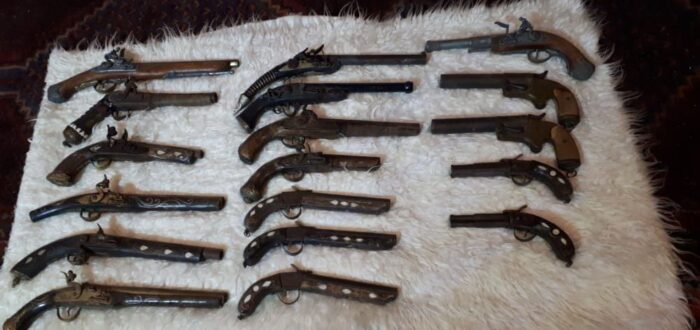Jack Shanley & Mick F.
Introduction
The conflict in Syria fuels a diverse trade in arms and munitions. Many transactions are performed online, providing an opportunity for remote analysis. This article is the fifth in a series of monthly updates to ARES Research Note 11: Analysing the Online Arms Trade in Opposition-controlled Syria. Readers should refer to that report for further information on methodology and context. These short updates will present ongoing analysis of the online arms market in opposition-controlled North and North-western Syria, focusing on the previous month (in this case, June 2021). After data has been collected for the whole of 2021, a full report will be released.
Key findings
- June 2021 saw a significant spike in sales, resulting in the highest total number of sales recorded within a month since this period of data recording began in December 2020;
- Documented sales of ammunition increased dramatically in June 2021, mostly as a result of two large sales;
- A number of antique weapons and replica firearms, likely originating with a hobbyist, were recorded for sale in June 2021, including a large number of muzzle-loading firearms;
- As with May 2021, light weapons were documented for sale in June 2021, in this case consisting of 3 single-use, shoulder-fired rocket launchers or recoilless weapons; and
- In congruence with previous months, a large number of blank-firing pistols were documented in June 2021, including a large single shipment similar to one documented in February 2021.
Describing the Dataset
Item by Class
In June 2021, 667 sales of small arms, munitions, and blank-firing pistols were recorded by ARES. This represents a substantial rise in sales—by more than 250 trades—when compared to May 2021 (398). In fact, June 2021 accounts for the highest number of sales yet documented since ARES began this period of monitoring sales in the region, in December 2020. June 2021 also saw a noteworthy increase in the number of documented munitions sales, which, for the first time, eclipsed those of small arms. This increase was almost entirely due to two large sales. In June 2021, three light weapons—all single-use shoulder-fired launchers—were documented for sale.
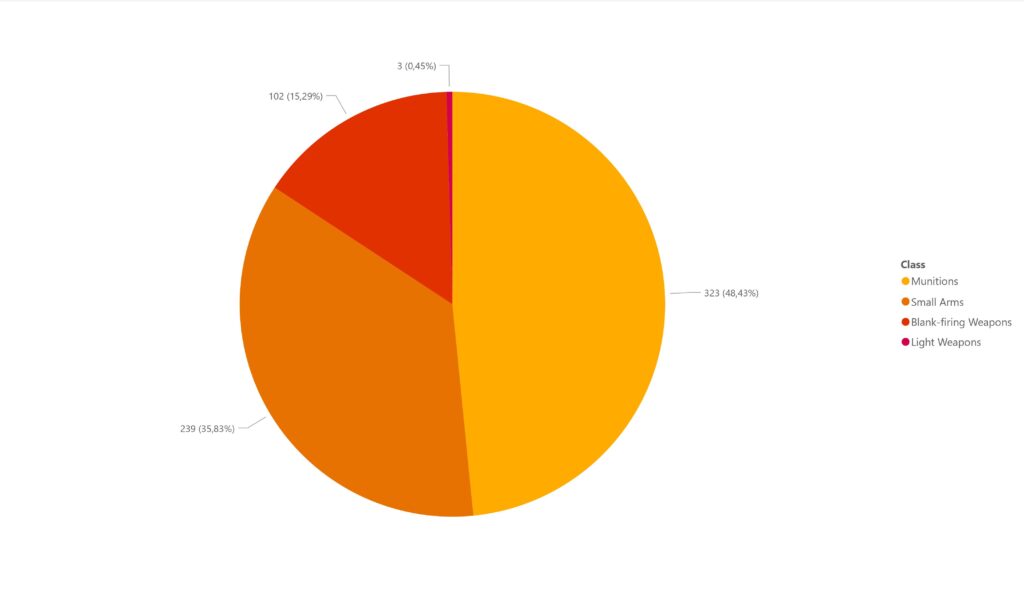
Small Arms by Type and Sub-type
The majority of documented lethal-purpose small arms trades related to rifles (48%), which matched the percentage of rifles documented in May 2021 (48%). Self-loading pistols were the second-most-common type of small arm documented, constituting 27% of the documented sales. This marks a 14% decrease in the proportion of self-loading pistol sales from May 2021 (41%). Additionally, 29 muzzle-loading handguns, nine submachine guns, seven manually operated (pump-action, double-action, and break-open) shotguns, one self-loading shotgun, five revolvers, five muzzle-loading long guns, and three hand-held machine guns were documented in the dataset.
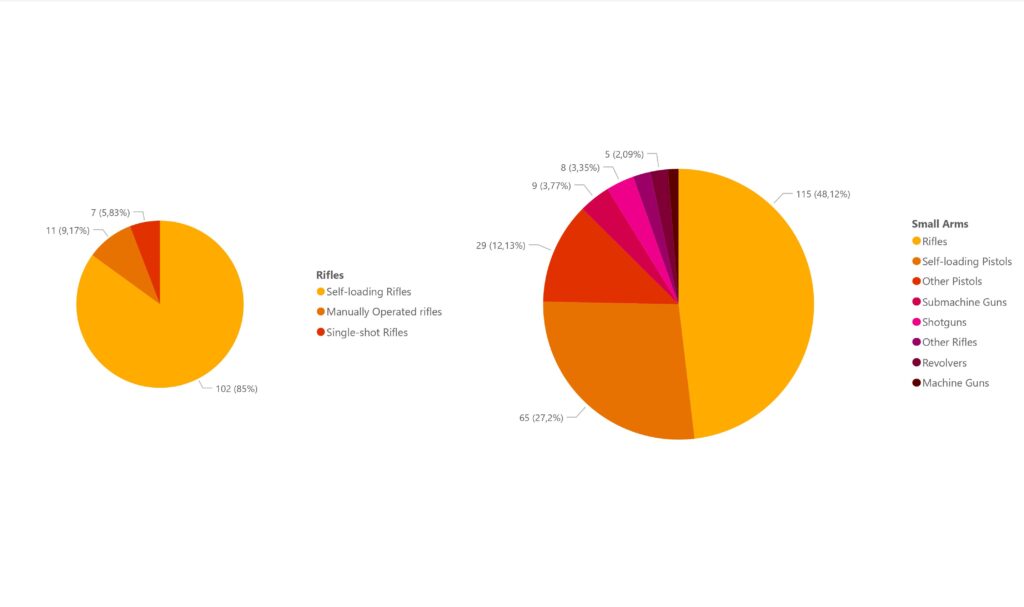
Small Arms by Country of Origin
It was possible to identify the national origin of 546 of the 667 documented items. Items of Turkish origin were the most common (accounting for 61% of all items traded), however the vast majority of these sales were of handgun cartridges (including both blank and lethal-purpose cartridges) or blank-firing pistols; only three offered lethal-purpose small arms or light weapons. No other nations were represented with significant frequency in the data. Sales of Chinese origin were the second most prevalent, but accounted for only 4% of offers documented in June 2021. When blank-firing weapons are eliminated from the analysis, the share of sales of Chinese origin increases by one percent (5%). Weapons could be identified from 23 different countries.
Self-loading Rifles by Family
Of the 102 documented self-loading rifles offered for sale in June, all could be identified by model or family. This month, 87 of the 102 documented self-loading rifles were AK-family weapons. Four of the AK-family weapons documented in June 2021 were AK-103-2 self-loading rifles, four were M70AB2 rifles, and two were Tabuk rifles. Only three of the documented AK-family weapons were chambered for the 5.45 × 39 mm cartridge, five fewer than last month. In addition to AK-family weapons, eight Sa vz. 58-series rifles, five SKS-pattern rifles, and two M16A1 rifles were recorded. Consistent with previous reports, the Sa vz. 58 commanded lower prices relative to AK-family rifles.
Self-loading Pistols by Model
There were 65 documented sales of lethal-purpose self-loading pistols in June 2021, 20 fewer than were documented in May 2021. The TT-pattern ‘Tokarev’ (14 examples), CZ vz. 70 (6 examples) and FN Herstal Hi-Power-pattern pistols (6 examples) were the three most commonly documented lethal-purpose self-loading pistols in June 2021.
Of the 102 blank-firing pistols documented, all but one were identifiable by model. The Turkish Aksa Silah AK14 model and Turkish Lord T822 constituted 68% (70 examples) and 21% (21 examples) of all recorded sales of blank-firing pistols, respectively. Since this period of monitoring began, this is only the second month in which the Lord T822 was not the most frequently documented model of blank-firing pistol.
Individual Sales of Interest
Large Sale of Turkish Aksa Silah AK14 Blank-firing Pistols
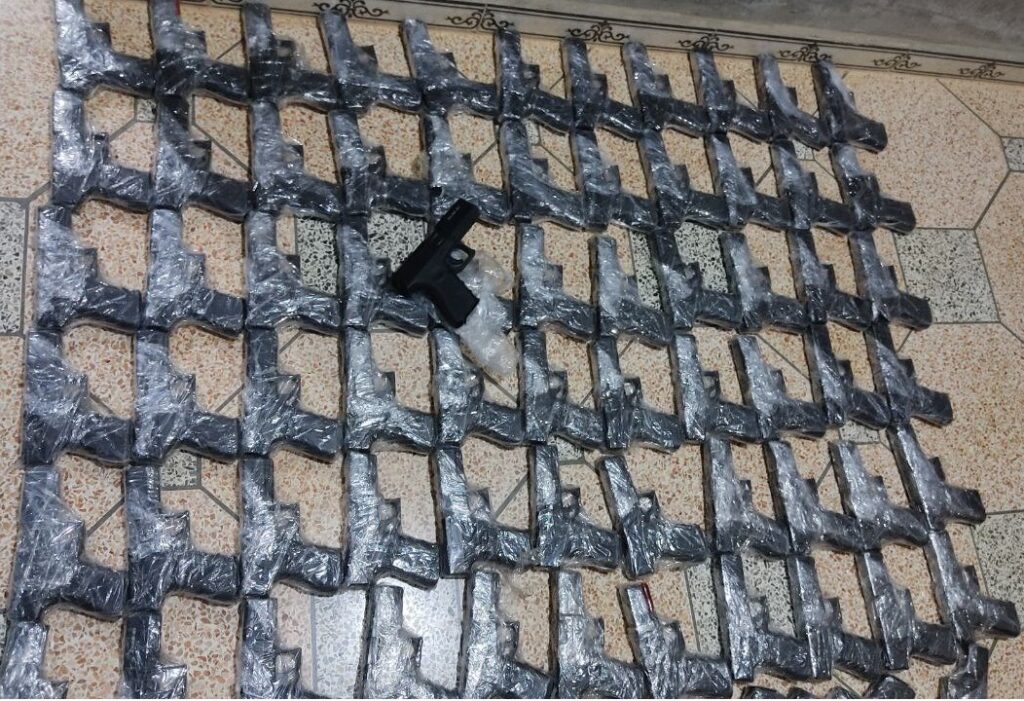
The most common blank-firing pistol documented this month was the Turkish Aksa Silah AK14. Its prevalence in the June 2021 dataset was primarily the result of a single large sale which happened mid-month. The packaging is similar to that seen in a previous large sale of blank-firing pistols (see the February 2021 update), which may indicate the items were transported over a relatively long distance. Indeed, the blank-firing pistols appear to have recently arrived in Idlib when photographed, and most likely originated in Turkey.
Muzzle-loading & Other Firearms
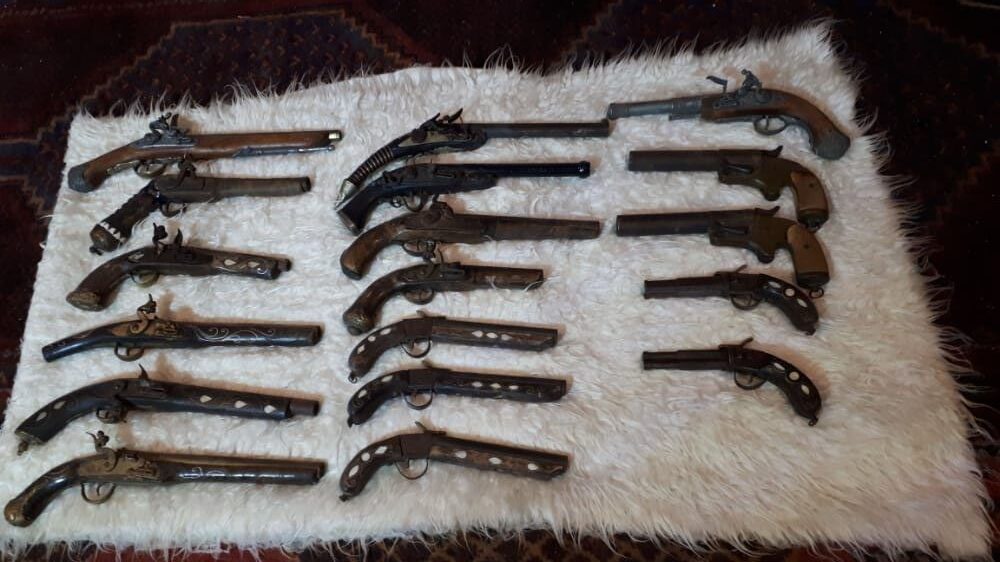
A considerable number of antique firearms were offered for sale in June 2021. Within these, ARES Technical Specialist Jonathan Ferguson identified a number of percussion pistols and shotguns, flintlock firearms, centrefire signal pistols, non-firing replicas, and a Nagant M1895-pattern revolver most likely produced in the Khyber Pakhtunkhwa region of Pakistan. He identified most of the flintlock and percussion weapons as being of North African style. One example—the third pistol down in the left-hand column of Figure 2.4—was identified as an Ottoman-style firearm. The weapons were of varied vintage; some examples potentially date back to the 1820s, whilst others are modern-day replicas. Ferguson noted that all of the weapons offered in this sale were “crudely made and/or in poor condition, and none hold any significant market value”. These weapons almost certainly originated from a private collection, having essentially zero value as combat implements in North-western Syria. Although research tends to focus on the procurement activities of combatants and other armed groups in conflict zones, civilian collectors also actively seek weapons in many of these areas.

M16A1 ‘Mekut’zrar’

This M16A1 has been modified in a manner which resembles an Israeli Mekut’zrar Carbine. The Mekut’zrar Carbine is essentially a shortened M16A1 (Colt 603) used in Israel Defense Forces (IDF) service. This example could be an original IDF version, or simply a weapon modified in a similar fashion. Note the missing serial number, which was removed by cutting a piece out of the lower receiver. If a true Mekut’zrar, weapon could have possibly originated from Lebanon, as Israel is known to have supplied M16A1 rifles to the Lebanese Forces Party during the Lebanese Civil War. This transfer is thought to have included Mekut’zrar Carbines. A confidential ARES informant notes that some of the weapons supplied to Lebanon were later sold to Syria following the outbreak of the Syrian Civil War. It is unknown which belligerents received these weapons.
Turkish MKE M204A1 Hand Grenade Fuzes
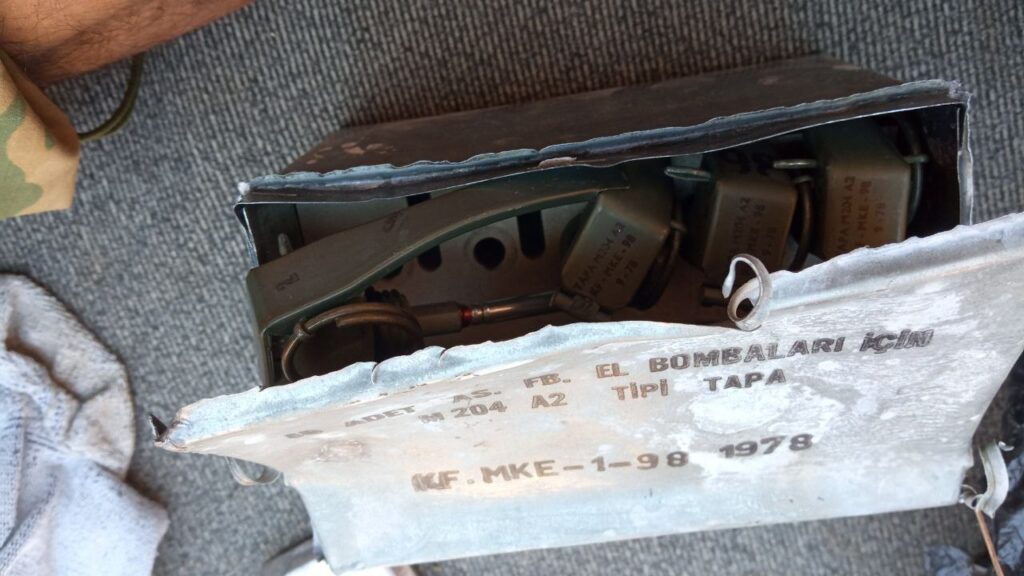
One interesting sale consisted of a box of TM204A1-pattern hand grenade fuzes manufactured in Turkey by the state-owned Makina ve Kimya Endüstrisi Kurumu (MKE). M204-series fuzes were developed in the United States and widely used with the American M26 hand grenade, but the simple and effective design has been widely copied around the world. MKE uses these fuzes with a number of their hand grenades, including their MK2 and MK3 high explosive fragmentation (defensive) models, as well as their MOD 48 high explosive (offensive) and MOD 56 riot control agent models. The examples documented were MKE M204A2 models, manufactured in 1978.
Turkish Blank & Lethal-purpose Small-calibre Cartridges

Two of the ammunition sales documented this month were particularly noteworthy. The first sale comprised a number of 9 mm PAK (Pistole Automatisch Knall; lit. ‘pistol automatic bang’, also rendered as Pistole Automatik Knall) blank cartridges, manufactured by Turaç Dış Ticaret Ltd. in Turkey and sold under their Kaiser brand. Although the sale of blank-firing weapons is very commonly documented, the sale of blank cartridges often takes place beyond the view of social media monitoring. Indeed, June 2021 marks the first documented sale of blank cartridges since ARES began this current period of monitoring sales in the region.
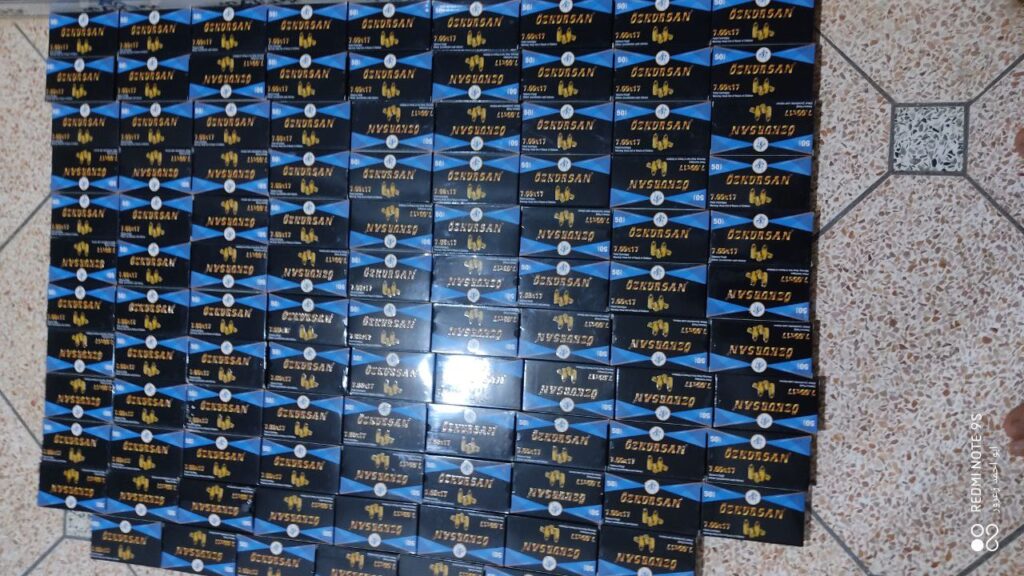
Two of the ammunition sales documented this month were particularly noteworthy. The first sale comprised a number of 9 mm PAK (Pistole Automatisch Knall; lit. ‘pistol automatic bang’, also rendered as Pistole Automatik Knall) blank cartridges, manufactured by Turaç Dış Ticaret Ltd. in Turkey and sold under their Kaiser brand. Although the sale of blank-firing weapons is very commonly documented, the sale of blank cartridges often takes place beyond the view of social media monitoring. Indeed, June 2021 marks the first documented sale of blank cartridges since ARES began this current period of monitoring sales in the region.
Sources
ARES. n.d. Conflict Materiel (CONMAT) Database. Confidential. Perth: Armament Research Services (ARES).
Ferguson, Jonathan & N.R. Jenzen-Jones. ‘Weapons Identification: Other Small Arms and Light Weapons’ in An Introductory Guide to the Identification of Small Arms, Light Weapons, and Associated Ammunition (Jenzen-Jones & Schroeder, eds.). Chapter 6. Geneva: Small Arms Survey. <http://www.smallarmssurvey.org/resources/publications/by-type/handbooks/weapons-id-handbook.html>.
Jenzen-Jones, N.R. (ed.). 2020. The ARES Arms & Munitions Classification System (ARCS). Perth: Armament Research Services (ARES).
Laffin, J. & M. Chappell. 1982. Arab armies of the Middle East wars, 1948–73. Oxford: Osprey Publishing.
Shanley, Jack & Mick F. 2021. ‘Analysing the Online Arms Trade in Opposition-controlled Syria: February 2021 update’. The Hoplite. 24 March. Perth: Armament Research Services (ARES). <https://armamentresearch.com/analysing-the-online-arms-trade-in-opposition-controlled-syria-february-2021-update/>.
Shanley, Jack & Mick F. 2021. Analysing the Online Arms Trade in Opposition-controlled Syria. Research Note 11. Perth: Armament Research Services (ARES). <https://armamentresearch.com/wp-content/uploads/2021/03/ARES-Research-Note-11-Analysing-the-Arms-Trade-in-Opposition-controlled-Syria-1.pdf>.
Silah Report. n.d. MENA Arms Trade Database. Confidential. Bloomington: Silah Report.
Remember, all arms and munitions are dangerous. Treat all firearms as if they are loaded, and all munitions as if they are live, until you have personally confirmed otherwise. If you do not have specialist knowledge, never assume that arms or munitions are safe to handle until they have been inspected by a subject matter specialist. You should not approach, handle, move, operate, or modify arms and munitions unless explicitly trained to do so. If you encounter any unexploded ordnance (UXO) or explosive remnants of war (ERW), always remember the ‘ARMS’ acronym:
AVOID the area
RECORD all relevant information
MARK the area from a safe distance to warn others
SEEK assistance from the relevant authorities

